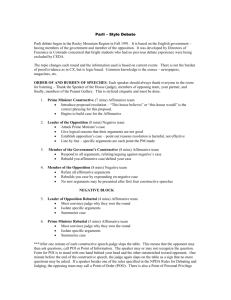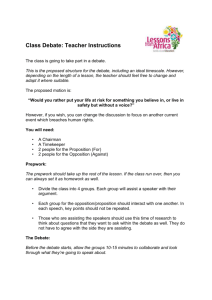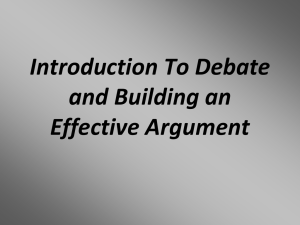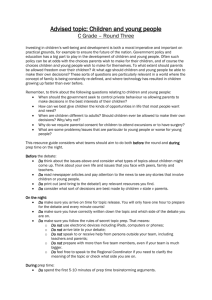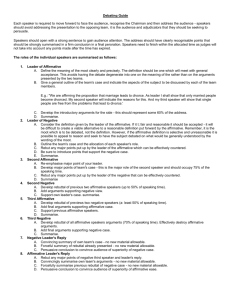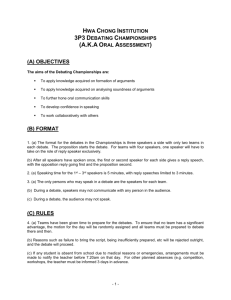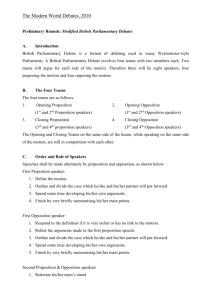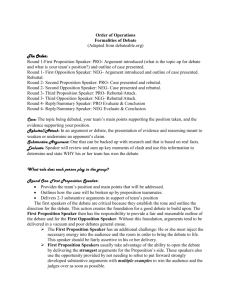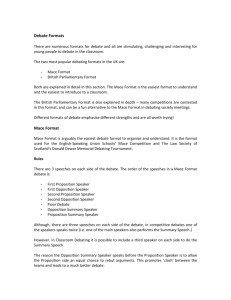Art and Higher Order Learning
advertisement
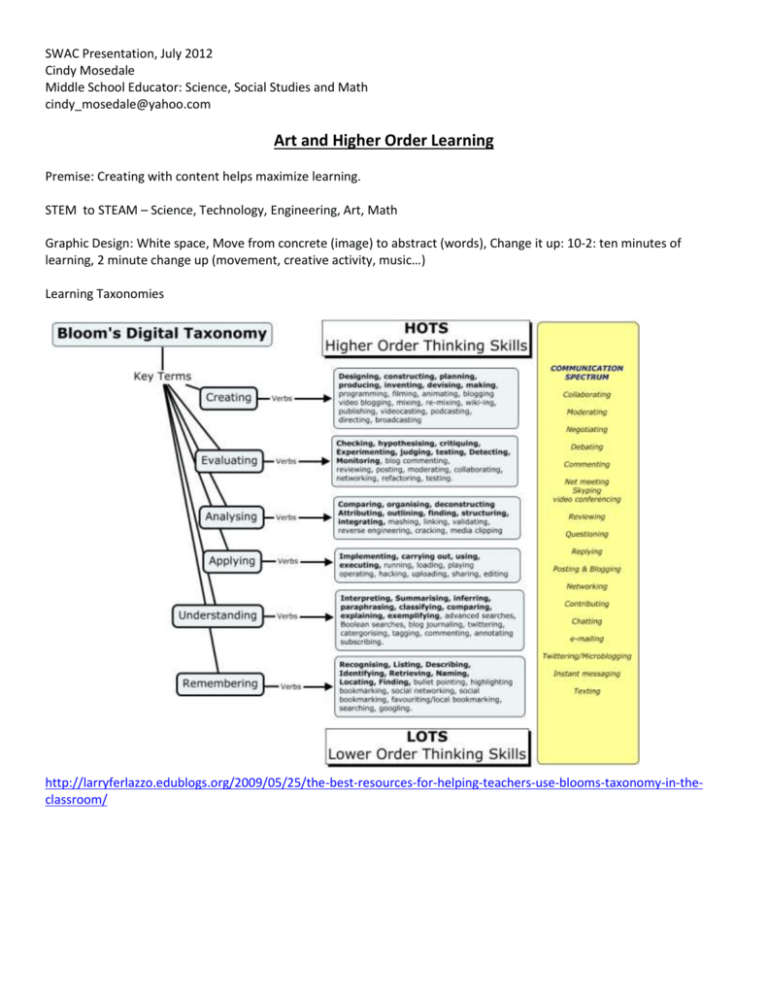
SWAC Presentation, July 2012 Cindy Mosedale Middle School Educator: Science, Social Studies and Math cindy_mosedale@yahoo.com Art and Higher Order Learning Premise: Creating with content helps maximize learning. STEM to STEAM – Science, Technology, Engineering, Art, Math Graphic Design: White space, Move from concrete (image) to abstract (words), Change it up: 10-2: ten minutes of learning, 2 minute change up (movement, creative activity, music…) Learning Taxonomies http://larryferlazzo.edublogs.org/2009/05/25/the-best-resources-for-helping-teachers-use-blooms-taxonomy-in-theclassroom/ Strategies 1. ZenTangles (20 mins): Four dots, Frame, Critical Thread, Designs and Message 2. Writing: formal and informal: Report, Persuade, Summarize, organize/list *Word Wall (10 mins) *Poetry (20 mins): o Portrait Poetry: http://www.tnellen.com/cybereng/portrait.html o Concrete Poetry o Biopoems: Version 1: 1 Noun: _______________ 2 Adjectives: _______________ _______________ 3 Verbs: _______________ _______________ _______________ One 4 Word Phrase: ________________________________________________________ 1 Feeling: _______________ Version 2: (Line 1) Subject (Line 2) Three or four adjectives that describe the subject (Line 3) An important relationship (Line 4) Two or three things, people, or ideas that are connected to the subject (Line 5) Three feelings associated with the subject (Line 6) Three sensations associated with the subject (Line 7) Four facts about the subject (Line 8) Two or three things the scientific community would like to see happen regarding the subject (Line 9) Subject location (Line 10) Take home message --------------------------------------------------------------------------------------------------------- -------Adapted from: http://www.readwritethink.org/files/resources/lesson_images/lesson398/biopoem.pdf, from Abromitis, B.S. (1994, June/July). Bringing lives to life. Biographies in reading and the content areas. Reading Today, 11, 26. Reprinted with permission of the publisher and author. 3. Tech Resources (15 mins) Brainstorming/Notes: Wordle*, Inspiration*… Collaboration: Titanpad*, facebook (Pintrest, Spotify…), Young Writer’s Project… Brain Gym (15 mins) Pong Professor Tuttle is going to the 2012 Earth Summit in Rio, an instructional framework for sustainable development, and she is bringing… 4. Debating: First proposition constructive (set a time limit, less than 1-5 minutes) This speaker makes a case for the motion for debate, providing a proof of the topic with three or four major points. First opposition constructive – (set a time limit, less than 1-5 minutes) This speaker makes several arguments against the proposition team’s case and refutes the proposition’s major points. Second proposition constructive – (set a time limit, less than 1-5 minutes) This speaker should rebuild and extend upon the proposition’s case. This means that this speaker must extend and amplify the original proposition points and refute the opposition’s major arguments against the case. Second opposition constructive – (set a time limit, less than 1-5 minutes) This speaker amplifies the opposition arguments against the case, providing new information about why the opposition team should win the debate. This speaker should answer the proposition’s answers to the opposition team’s original arguments. Opposition rebuttal – (set a time limit, less than 1-2 minutes) This speaker must put the debate together and explain why, given all of the arguments in the debate, the opposition team should still win the debate. Should finalize refutation of the proposition’s major points. Proposition rebuttal – (set a time limit, less than 1-2 minutes) This speaker should summarize the issues in the debate and explain why, even with the opposition’s arguments, the proposition teams should win the debate. Should refute the opposition’s major points. Points of information Maybe a statement or a question. Can only be attempted during the middle three minutes of each constructive speech. May not be more than 15 seconds long. The speaker must recognize you to make your point. If the speaker does not recognize you, you must sit down. Taken from: http://www.middleschooldebate.com/documents/shuster.idea.paper.pdf Published on idebate.org (http://idebate.org) Home > Debate of the Masses Debate of the Masses Working with whatever size group you have, divide the group into two halves: affirmative and negative. Then divide each of those groups into two halves: the first affirmatives and the second affirmatives, etc. Pick a topic with which the students are already familiar, or one on which they can easily generate ideas. You start by having half of the affirmative speakers get up in turn and present one single argument (no more than 30 seconds each). Everyone is instructed to write down and number each point, so if there are ten affirmative speakers in the first point, they should have numbered arguments one through ten in the first column of their notes. Before the affirmatives start, let the first negatives know that they will be responsible for refuting one of the affirmative arguments (have the speakers numbered in a sequence so that if a person is negative #7, then they know they refute the 7th affirmative argument. Once the first group of affirmative speakers have finished, have the first group of negative speakers answer each of the affirmative points. Following this, the second group of affirmative speakers are up. Their goal is to defend one of the original affirmative arguments by attacking the negative response to that argument. Again, each person has a number, so affirmative #3 would be expected to defend the 3rd affirmative argument by attacking what the negative says against that argument. Finally, the second group of negative completes the process in the same manner. If you like, you can add judges who present a decision. For instructors, the goal is to have an informal free-flowing exchange and to keep things moving so that everyone speaks. Even if the arguments arent very good, students will get the idea of structure and given the numbers you should hear at least a couple of good arguments and good answers. Source URL: http://idebate.org/training/teaching-tools/debate-of-the-masses
